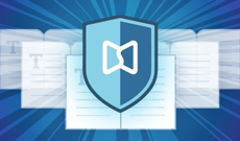Content remains king—but even the king’s treasures can be stolen if they aren’t kept safe.
Essentially, while digital marketing has raised the game where sales are concerned, businesses still need to take appropriate measures to ensure their awesome content isn’t stolen or used for other means. If you don’t, you run the risk of being hacked and/or plagiarized, and your own brand’s reputation could be damaged. You need to do whatever it takes to keep your content safe and secure.
The good news is that, as scary as stolen content sounds, safeguarding your content is actually pretty easy. Let’s take a look at 5 actionable steps you can take to upgrade your content security.
#1 Go Digital
First things first, you should move your content online if you haven’t done so already. Online content is safer than offline content, although it still comes with a few risks.
For example, many of us secure our content by converting it into a PDF. While this can prevent our content from being copied, it can’t prevent it from being shared with the wrong people. Tools like FlippingBook can help in this regard, as the tool puts you in control of how your content is distributed. You decide who shares it and with whom. FlippingBook helps you protect your sensitive online content with a password so only select viewers have access to it. This helps prevent many possible threats like social security theft, identity theft, and phishing. Plus, you can disable share, print, and download options, making your content available for viewing only.
Also, while going digital is safer than leaving your content lying around the office, you’ll still need to protect your physical assets, such as your laptops, with anti-malware software (for instance, Norton, Bitdefender, or Malwarebytes).
#2 Tighten Security On Your Team Project Apps
Many small businesses use apps like Trello and Slack to help with their content marketing strategies. Trello and Slack are awesome tools because they connect teams and keep them on the same page.
The problem is that whole teams have access to shared content on these apps, which can create its own issues. People might become forgetful and misplace a password, for example.
It’s really important that you create long, bulletproof passwords for each user. You can do this by making it long, using a mix of characters, and avoiding common substitutions (such as Pa88word for “password”).
Plus, you can use 2-step verification, as this will further bolster your content security on these apps.
#3 Tighten Your Email Marketing Security
Email marketing remains a key part of many online businesses’ content marketing strategies. But email is also a big target for hackers. And the thing is, hackers aren’t just targeting your content —they’re also targeting your customers.
It’s really important that you protect your customers’ details, as trust between consumer and brand is key to a successful online business. You can do this by using a reputable email marketing software, such as MailChimp, which comes with in-built security.
But you should also train your staff in online security so that they learn more about the likes of phishing and security hygiene, as well as how to keep email marketing campaigns safe. Training is essential because human error is usually the cause of a data breach.
It’s also a smart idea to warn your customers about spam and junk mail. We might be in 2020, but customers are still wary about handing over their email addresses to brands, out of fear their details might be leaked. Educate your customers on online security. Let them know you take it seriously and point out what real spam looks like.
#4 Use VPNs When Sharing Content
A great way to protect your content is a virtual private network. It’s a virtual private network that adds extra layers of privacy protection (including SSL securities) so that hackers can’t keep up with your online movements. How so? Because you’re essentially changing your IP address. Without your IP address, hackers find it very difficult to track you, thereby preventing a third party from accessing your content.
#5 Always Use a Secure Web Hosting Service
We can’t stress enough how important it is that you always use a secure web hosting service. If you do, your content is a whole lot safer than it otherwise would have been.
WordPress is a popular service, but there are lots more to choose from. When shopping for a web hosting service, make sure to read customer reviews and look for one with good server-level security. Aim for a DDoS protected VPS when choosing a platform.
If you’re thinking about cloud hosting, you have to choose the secure platform, the one that people can really trust. FlippingBook uses highly-reliable Amazon servers to ensure that your flipbooks are protected from unwanted access, securely hosted, and load fast.
A good web hosting service sometimes comes complete with an SSL certificate. If it doesn’t, it’s really important that you purchase one as soon as possible. An SSL certificate helps to keep your content safe, but it’s also a sign of approval that helps to give your customers peace of mind before they visit your website. You can also make your website secure with RapidSSL wildcard that can secure your main domain and first level of subdomains with strong encryption in case if you are running an ecommerce.
These are 5 actionable steps you can take to upgrade your content security. Doing so will minimize the risk that your content will be hacked and used by other websites for other purposes. It will also ensure your customers’ details are safer, too.
That said, no tactic is 100% bulletproof. In the event that your content is copied/stolen, it’s important that, if possible, you get in touch with the culprit as soon as possible. Let them know they’ve done wrong, and ask them to take your content down.
Author's bio





